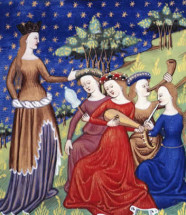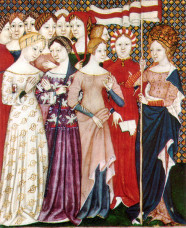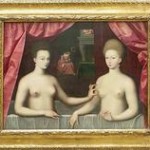Late-medieval Avignon was a city of men. A vast number of clerics were employed by the Pope and cardinals, and foreign merchants, craftsmen, and artisans swelled the ranks of local people providing services to the church. The city was a cultural and economic magnet, an attractive place to set up shop. It was also notoriously corrupt.
Di Marco Datini, for instance, the famous “merchant of Prato”, ran a lucrative arms business and sold religious bric-a-brac as a sideline, but left his wife safely at home in Prato. Francesco Petrarch’s father was a notary in the city, but rented a house for his wife and two sons in Carpentras. In Avignon, he took a mistress and fathered an illegitimate daughter. According to an apocryphal story, a nugget for a novelist like me, one of the popes ordered the Petrarch brothers to send their sister to the palace to entertain him.
I trusted my intuition about medieval people to guide me through the early drafts of Muse and only later discovered registers and a census that provided details about the population. From these I learned that women came to Avignon with the same goal as the men: to better their lives in the papal city. They didn’t travel as far as the men to get there; most female immigrants came from elsewhere in France. These cortisiani were registered, as were the female citizens, in the traditional way as daughters, widows, or wives (femmes couvertes) of a male head of the household.
Normally, a father betrothed his daughter by legal contract to a suitable husband. The marriage took place soon afterwards and the dowry changed hands. As the teenaged daughter of a nobleman, Laura de Noves would have been betrothed when Petrarch first became infatuated with her. She married Hugues de Sade and bore him eleven children. According to Petrarch’s dialogue Secretum, she was worn out by childbirths by her mid-thirties.
If no marriage could be arranged, the daughter and her dowry might be given to a convent, as several of Laura’s daughters were. For some girls, this might have been an attractive alternative to marriage, since a nunnery provided a stable environment and some job satisfaction. The day was organized by the religious hours and each nun had a role, such as cellaress, chambress, or librarian. If the girl was given to an order like the Benedictines, she might receive a good education, as Solange did. Nuns could become scribes, like monks, although as we see with Solange, the book industry was beginning to move from the abbeys to the university cities like Avignon. The most talented nuns might aspire to be abbesses or even saints.
A woman from the working class had a hard life, but she was possibly more free to marry someone she liked, though it’s best not to let our minds stray into infrequent bathing, lack of toothbrushes, and fleas in the marriage bed! The living conditions of such a woman varied according to the status of her husband. She might work at his trade and take over the business if he died. Widows could head households, run the family shop, and beat lazy apprentices.
Scholars have scrutinized the registers to decipher why more than half the women in Avignon reported themselves as single (femmes seules), yet didn’t give occupations or surnames. The explanation put forward by male historians is that they were prostitutes. Even some feminist scholars have concluded this after vainly searching for other interpretations.
Medieval clerics had been forbidden to marry since the First Lateran Council, most likely so the church could enrich itself by inheriting their worldly goods. However, human nature found ways to detour around this roadblock. As I had speculated during the early drafts of Muse, the glut of unmarried clerics in Avignon created a high demand for prostitutes, who ranged from tavern whores to the spectacular courtesans favoured by the cardinals and Pope. It was openly known that many of the cardinals’ nephews were actually their sons.
To maintain order, the city marshal charged each harlot two sols a week and regulated the distance of each bawdyhouse from the nearest church or cardinal’s livrée, revealing that brothels were squeezing as close as they could to their religious clients. Although the harlots lived in brothels or red-light districts outside the city wall, the sumptuary laws rebuked them for sporting fancy jewellry and rich clothing, which suggests they were able to buy such luxuries and flaunted them in public. In this most patriarchal of cities, prostitution was an accepted way to provide sexual services to the large number of single men.
Although it was legal, prostitution was still a sin. Do-gooders tried to reform the women and house them in the repenties of the Magdalen, modelled on convents. However, there was no rush to sign up, since prostitution paid well. To sentimentalize this trade and turn the harlots into victims would be to miss the point. No doubt these women had originally travelled to Avignon with the intention of making a good living in this very manner.
In the thriving city of Avignon, where gender and social class wielded great power, single women like Solange made the most of the opportunities available to them and strove to acquire a trade, gain an economic foothold, and improve their living conditions in inventive ways.
This post first appeared at the blog Be Nice or Leave, Thanks



